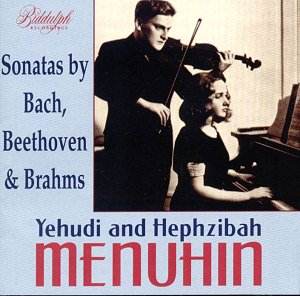It was a perceptive move to bring together these canonical recordings in one slim-line double. Yehudi’s celebrity tended to overshadow that of his sister Hephzibah but as these recordings show she was a formidable musician, quite capable of meeting her brother on equal terms in this repertoire. The recordings date from a six-year period that takes one to his first musical crisis, in the early 1940s.
His later recording of the Bach Sonata in E with Landowska may be slightly better known than this earlier recording but with Hepzibah his reading is convincing and fluent albeit not untouched by technical intimations of things to come. There’s a bad fluff at 3.50 in the Adagio – though it’s a testament to their collective confidence that this take was preferred to any other – and some passagework escapades in the succeeding Allegro. Still there is a communing intensity in the Adagio ma non tanto and dramatic interplay between brother and sister in the finale. There are a trio of Beethoven Sonata recordings, the C minor and No. 10 in G dating from 1938 and the Kreutzer from 1934. Taking the earliest recording first there is a troublesome sense of withdrawn passivity and deliberation about the opening movement. It strikes me as unconvincing architecturally and lacking in real thematic understanding – not a judgement I’d make of Hepzibah. The young Menuhin sounds happier in the variations second movement, if sometimes just a bit too fluent, but in the finale things are again a bit bogged down with moments of lyricism contrasted rather too knowingly. It’s a youthful, as yet not yet formed interpretation from the eighteen year old.
The C minor Sonata sounds much better in structural terms in that sense even if Menuhin’s tone does tend to coarsen at times whilst the final Sonata gets a youthfully robust reading, the slow movement never really probing too deeply below the surface of the notes. The isolated movement from the Eighth Sonata is rather cautious but not unattractive. Which leaves the Brahms. Op. 78 opens in a rather italicised way, not at all flowing, but though there are one or two unsteady moments from Yehudi his evocative vibrato can still bewitch. The Adagio has an almost incantatory fervour with some succulent finger position changes with one or two lesser technical problems. Of the two sonatas the D minor is the better played; Hephzibah snatches at a few phrases in the opening movement but there is plenty of lyric nobility in the slow movement even if they cannot match the unerring rightness that Szigeti and Petri generated in their almost contemporaneous recording for English Columbia.
The copies used are clean sounding Victors – in preference I should think to the noisier English HMVs – though the Adagio of the Brahms D minor is rather crackly. No one looking to have a collection of sonata performances by this charismatic duo need hesitate.
Jonathan Woolf
